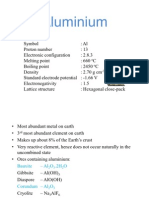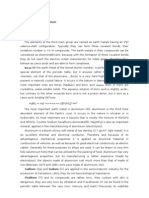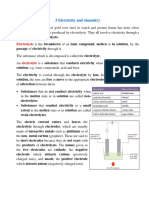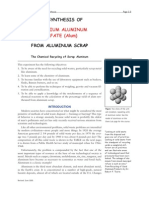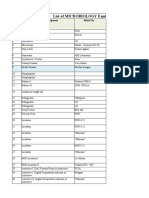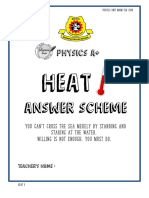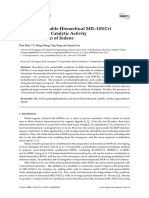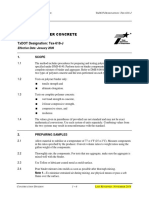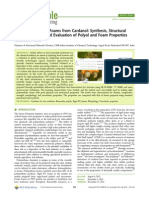Presentation 1
Presentation 1
Uploaded by
PeNgHoOiCopyright:
Available Formats
Presentation 1
Presentation 1
Uploaded by
PeNgHoOiOriginal Description:
Copyright
Available Formats
Share this document
Did you find this document useful?
Is this content inappropriate?
Copyright:
Available Formats
Presentation 1
Presentation 1
Uploaded by
PeNgHoOiCopyright:
Available Formats
As density is the ratio of mass to volume, increment in mass outweigh increase in volume.
Thus, density increases going down the group. Boiling point decreases down the group as the electrical attractive forces between the immobile ions in the metal lattice and the free mobile delocalised electrons decreases due to increment in atomic radii.
atomic atomic mass number (amu) Metalloid valence electron configuration melting point/boiling point (C)
Atomic radius increases down the group as an extra inner shell of electrons is added per period.
density (g/cm3) at 25C
most common atomic oxidation electrone radius (pm) state gativity
Metallic character increases down the group as ionization energies decreases.
Boron Metal Aluminium Gallium Indium Thallium
10.81
2s22p1
2075/4000
2.34
87
13 31 49 81
26.98 69.72 114.82 204.38
3s23p1 4s24p1 5s25p1 6s26p1
660/2519 29.7/2204 156.6/2072 304/1473
2.7 5.91 7.31 11.8
118 136 156 156
3 3 3 1
1.6 1.8 1.8 1.8
Diagonal relationship
Refers to pairs of diagonally adjacent elements in the second and third periods of the periodic table. Results in similarity among atomic size, electronegativity and properties of compounds.
Group 13 elements generally have +3 oxidation state. However, lower oxidation state is getting more stable descending the group. Eg. Tl+ has a +1 oxidation state.
ns2np1(p block)
General Features of Group 13
Aluminium third most abundant element (after oxygen and silicon)
Melting point Boiling point Density 660 C 2520C 2.70gcm-3
metallic ( except boron , which is a solid metalloid ) chemically reactive at moderate temperature ( except boron ) scarce in nature ( except aluminium , which is the most abundant metallic element ) High charge density leads to high polarising power. This gives rise to the significant of covalent characteristics among group 13 compounds.
Major factor : charge density among the pairs are relatively similar. Proof: boron and silicon are both semiconductors, forming halides that are hydrolysed in water and have acidic oxides. Both Be 2+ and Al 3+ are hydrated to produce [Be(H20)4]2+ and [Al(H2O)6]3+ respectively. Another similarity between aluminum and beryllium is that they are amphoteric. Both metals also react with oxygen to produce an oxide coating that protects other metals from corrosion. Both metals can also react with halides that can act as Lewis acids.
Reactivity and metallic characteristics
They have three electrons in their outermost shell (a full S orbital and one electron in the P orbital) with the valence electron configuration: ns2np1. The Boron Family has oxidation states +3 or +1. The +3 oxidation states are favorable except for the heavier elements, such as Tl, which prefers +1 oxidation state due to its stability. This is known as the inert pair effect. Electrode potential increases going down the group (reactivity decreases as going down group) Ionization Energy decreases going down the group (since the electrons are farther from the core and due to screening effect, therefore are easier to remove). *Tl
does not follow normal trends
Electronegativi 1.6 ty (pauling scale) Crystal structure Facecentered cubic
Thallium -Common uses of Thallium include rat poison, insecticide, and treatment of skin infections
Aluminium -Impure Al2O3 are found as gemstones such as ruby and sapphire. -Recycling aluminium saves 95% of energy required to produce new aluminium. -Aluminium is somehow might cause Alzheimers Disease based on recent research.
versatile => ductile and malleable generally, Al forms ionic compounds with covalent characteristics due to high charge density which makes it polarize the electron cloud of an anion. Thus, Al is a strong reducing agent. Example: aluminium oxide 2050C strong ionic bond between Al3+ and O2- with significant covalent characteristics >> amphoteric. Al2O3(s) + 6HCl (aq) 2AlCl3 (aq) + 3H2O(l) Al2O3(s) + 2NaOH (aq) +3 H2O 2NaAl(OH)4 (aq) Al2O3 catalyst in cracking of alcohol & dehydration of alkene, stationary phase in column or thin layer chromatography, refractory furnace bricks. Aluminium as alloy Aluminium is added in duralumin and magnalium for manufacture of body of aircraft and engine block. Interesting facts: A) When 2 molecules of AlCl3 meets, dimerisation will occur. One of the lone pair of one of the Cl atom of each AlCl3 will form dative bond with empty 3d orbital of the other Al atom, forming a dimer, Al2Cl6. B) Aluminium wire is used in overhead high tension cables, replacing old copper wire due to lighter weight and conductivity of aluminium. C) Acidic property of Al3+ ion In aqueous solution, Al3+ ions able to attract 6 water molecules to form 6 dative bonds, forming hexaaquaaluminium(III) ion. Due to high charge density of Al3+ ion it withdraws the electron density from the O-H bonds in the water molecules, thus weakening the bonds. As a result, water molecule of the hexaaquaaluminium(III) ion acts as Bronsted-Lowry acid and donates H+ ions. D) Despite aluminium is reactive, Al is resistant against oxidation. Why? When Al exposed to air, it forms a thin, non-porous and impenetrable oxide layer of Al2O3 on the surface which protects the aluminium from further attack by oxygen or dilute acid.
0CCURANCE
Do not occur elementally in nature due to their high reactivity in its elemental state. B - Na2 [B4O5(OH)4]8H2O (borax), H3BO3 (boric acid) Al - bauxite (Al2O3), cryolite (Na3AlF6) << to reduce the melting point of bauxite Ga - byproduct of aluminum refining In - byproduct of lead refining Ti - byproduct of lead refining Boron -Boron produces a green flame. -Boron is present in laboratory glass wares. It has low thermal expansion. -Research indicates Boron may be beneficial for the treatment of arthritis.
Indium -A thin layer of indium tin oxide can be found on LCD displays, such as through the monitor in which you are reading this.
Boron
Only semi-metal of this group. Electron deficient compound, make it a strong Lewis acid. Due to its lack of a complete octet Boron is a Lewis acid, so it forms hydrides and the simplest boron hydride found is diborane, B2H6. Eg. Widely used in synthesis of organic compounds. Essential nutrients for plants. Boron (B) deficiency is the most widespread micronutrient deficiency around the world and causes large losses in crop production both quantitatively and qualitatively. Boron deficiency affects vegetative and reproductive growth of plants resulting in inhibition of cell expansion, death of meristem and reduced fertility.
References
1. Ralph H. Petrucci, F. Geoffrey Herring, Jeffry D. Madura, Carey Bissonnette. General Chemistry: Principles and Modern Applications, 10th ed. Canada, Toronto, Ontario: Pearson Canada; 2010. 2. Author unknown. Ruby. http://gem5.com/stone/100/ruby/#sthash.aJBQohkf.dpuf (accessed 13 Dec 2013). 3. Author unknown. Alzheimer's Again Linked To Aluminum. http://www.rense.com/general37/alum.htm (accessed 13 Dec 2013). 4. Shriver & Atkins. Inorganic Chemistry, Forth Edition ed. The United Kingdom: Oxford University Press; 2006. 5. Author unknown. Boron. http://www.webelements.com/boron/chemistry.html (accessed 14 Dec 2013). 6. Author unknown. The Element of Group 13. http://2012books.lardbucket.org/books/principles-ofgeneral-chemistry-v1.0/s26-01-the-elements-of-group-13.html (accessed 16 Dec 2013). 7. Author unknown. Group 13. http://www.rsc.org/chemsoc/visualelements/pages/data/intro_groupiii_data.html (accessed 1 Jan 2014).
Gallium -Due to it's melting point, gallium melts in your hands.
Group members: Lee Peng Hooi (BP0913034147), Chen Wei Yin ( BP0913034069), Nur Farah (BP0913034089), Siti Khadijah (BP0913034202), Yue Lee Kuan (BP0913034222), Denise Wong (BP0913034229), Kok Chee Leng (BP0913034242), Tang Kar Foong (BP0913034296), Yeap Wei Leng (BP091303430), Lim Kai Xin (BP0913034303), Cheng Huei Sze (BP0913034308)
You might also like
- Quiz 15Document6 pagesQuiz 15Hằng Thanh100% (1)
- P BlockDocument29 pagesP BlockVishal SNo ratings yet
- ThepblockelementsDocument56 pagesThepblockelementsAshutosh Ganesan92% (13)
- Group 13 The Boron FamilyDocument130 pagesGroup 13 The Boron Familystella jovita0% (1)
- Group 13 AluminiumDocument48 pagesGroup 13 AluminiumLooi Chui Yean100% (1)
- 13,14 Group TheoryDocument29 pages13,14 Group TheoryAlkaChoudharyNo ratings yet
- Aluminum: Aluminum in Periodic TableDocument5 pagesAluminum: Aluminum in Periodic TableKajal PandaNo ratings yet
- Group IIIA: The Chemistry of AluminumDocument12 pagesGroup IIIA: The Chemistry of AluminumEvgeni GenevNo ratings yet
- P Block Element Group 13Document18 pagesP Block Element Group 13ifefxxNo ratings yet
- The P-Block ElementsDocument20 pagesThe P-Block ElementsNabiha KaleemNo ratings yet
- Earth MetalsDocument27 pagesEarth MetalsAmanda PachecoNo ratings yet
- Revision Notes Class 11 Chemistry Chapter 11 - The P-Block ElementsDocument44 pagesRevision Notes Class 11 Chemistry Chapter 11 - The P-Block ElementsDevashree NaikNo ratings yet
- Aluminium and Its Compound A. BackgroundDocument8 pagesAluminium and Its Compound A. BackgroundNur Ayu Pertiwi HasmanNo ratings yet
- Aluminium MetallurgyDocument3 pagesAluminium MetallurgyShubham ShuklaNo ratings yet
- Aluminum CorrosionDocument1 pageAluminum CorrosionthanhnguyenhhvnNo ratings yet
- AluminiumDocument20 pagesAluminiummradu1No ratings yet
- 5 Electricity and Chemistry: ElectrolysisDocument12 pages5 Electricity and Chemistry: Electrolysistotatote034No ratings yet
- Universidad Nacional de San Antonio Abad Del Cusco: Facultad de Ing. Geológica Y GeográficaDocument24 pagesUniversidad Nacional de San Antonio Abad Del Cusco: Facultad de Ing. Geológica Y Geográfica321fuego321No ratings yet
- Grupo IIIDocument22 pagesGrupo IIIAbril ArteagaNo ratings yet
- Discussion of RustingDocument15 pagesDiscussion of RustingShamil Azha Ibrahim0% (1)
- UNIT 5 Grade 10Document97 pagesUNIT 5 Grade 10tya686744No ratings yet
- Laporan Unit 1 Anorganik Mutia Salsabila PDFDocument47 pagesLaporan Unit 1 Anorganik Mutia Salsabila PDFMutia SalsabilaNo ratings yet
- Summary of Trends in Chemical Properties of Group 1 Up To Group 18 and Their CompoundDocument18 pagesSummary of Trends in Chemical Properties of Group 1 Up To Group 18 and Their Compoundscoin502No ratings yet
- Inorganic Chemistry: Group 13 AluminiumDocument38 pagesInorganic Chemistry: Group 13 AluminiumLooi Chui Yean0% (1)
- Lec 5Document18 pagesLec 5Khaled AbeedNo ratings yet
- Alum ExptDocument10 pagesAlum ExptRivy Valen PabesakNo ratings yet
- Le 4Document37 pagesLe 4alaialiNo ratings yet
- The Positive and Negative Aspects of ChemistryDocument42 pagesThe Positive and Negative Aspects of ChemistryScribdTranslationsNo ratings yet
- Chapter # 4 Chemistry Class - XII P-Block ElementsDocument10 pagesChapter # 4 Chemistry Class - XII P-Block ElementsSharoon JohnNo ratings yet
- The Importance and Negative Impact of Electrochemical IndustriesDocument4 pagesThe Importance and Negative Impact of Electrochemical IndustriesSally ChewNo ratings yet
- LEC 01 - P-BLOCK - 11thDocument36 pagesLEC 01 - P-BLOCK - 11thprincemahyavanshi47No ratings yet
- Experiment I Aluminium and Its Compound 1.1 ObjectivesDocument9 pagesExperiment I Aluminium and Its Compound 1.1 ObjectivesAhlish Rahma AlfianaNo ratings yet
- AluminiumDocument19 pagesAluminiumAnkur Jain100% (1)
- The Extration of The Versitile AluminiumDocument36 pagesThe Extration of The Versitile Aluminiumvishnu_c_singhNo ratings yet
- Determination of Copper Complex II Coordination NumberDocument18 pagesDetermination of Copper Complex II Coordination NumberHasrilia BeskaraNo ratings yet
- The P-Block Elements - Shobhit NirwanDocument20 pagesThe P-Block Elements - Shobhit NirwanAadarsh PandeyNo ratings yet
- Tarnish & CorrosionDocument18 pagesTarnish & CorrosionPreeti AgarwalNo ratings yet
- Aluminium Oxide - Wikipedia, The Free EncyclopediaDocument7 pagesAluminium Oxide - Wikipedia, The Free Encyclopediad_richard_dNo ratings yet
- The P-Block ElementsDocument14 pagesThe P-Block ElementsAbhay100% (2)
- Organic Chemistry Question and AnswerDocument53 pagesOrganic Chemistry Question and Answergoi_pin100% (1)
- Organic Chemistry Question and AnswerDocument53 pagesOrganic Chemistry Question and AnswerApex InstituteNo ratings yet
- Tarnish and Corrosion: DefinitionsDocument3 pagesTarnish and Corrosion: DefinitionsangelrasNo ratings yet
- Cbse Test Paper 03 03 Metal and Non MetalsDocument6 pagesCbse Test Paper 03 03 Metal and Non MetalsrakeshmiyapuramNo ratings yet
- Boron Family Carbon FamilyDocument33 pagesBoron Family Carbon Familyr53654300No ratings yet
- Chemistry Notes Pt. 2Document124 pagesChemistry Notes Pt. 2Blohsh KeenenNo ratings yet
- Aluminum - Oxide Production ProcessDocument1 pageAluminum - Oxide Production ProcessAbdur Rahim WaseemNo ratings yet
- Managing Wastes From Aluminium Smelter Plants 1st Edition B. Mazumder All Chapter Instant DownloadDocument84 pagesManaging Wastes From Aluminium Smelter Plants 1st Edition B. Mazumder All Chapter Instant Downloadkubasszimela100% (2)
- P Block Group 13,14 TheoryDocument29 pagesP Block Group 13,14 TheoryShreyansh RaiNo ratings yet
- Golongan Iiia and Iva Elements: Na B O ODocument2 pagesGolongan Iiia and Iva Elements: Na B O OWanda Nafisah HamidahNo ratings yet
- Group 13Document4 pagesGroup 13Surisetti Jyothsna Latha100% (1)
- Properties of MetalsDocument72 pagesProperties of MetalststeadmanNo ratings yet
- Rusting of IrDocument14 pagesRusting of IrRohit MishraNo ratings yet
- Gen Chem 2 Q4 Week 8.d F With QA v.1 BETADocument15 pagesGen Chem 2 Q4 Week 8.d F With QA v.1 BETAAllona Jane BrionesNo ratings yet
- Why Do Metals Rust? An Easy Read Chemistry Book for Kids | Children's Chemistry BooksFrom EverandWhy Do Metals Rust? An Easy Read Chemistry Book for Kids | Children's Chemistry BooksNo ratings yet
- Extractive Metallurgy 2: Metallurgical Reaction ProcessesFrom EverandExtractive Metallurgy 2: Metallurgical Reaction ProcessesRating: 5 out of 5 stars5/5 (1)
- A Closer Look at Silicon - Chemistry Book for Elementary | Children's Chemistry BooksFrom EverandA Closer Look at Silicon - Chemistry Book for Elementary | Children's Chemistry BooksNo ratings yet
- GCSE Chemistry Revision: Cheeky Revision ShortcutsFrom EverandGCSE Chemistry Revision: Cheeky Revision ShortcutsRating: 4.5 out of 5 stars4.5/5 (3)
- Class 10 Chemistry Homework AssignmentDocument3 pagesClass 10 Chemistry Homework AssignmentTheboss SharmaNo ratings yet
- Manufacturing Program Programme de Fabrication: Programa de FabricaciónDocument11 pagesManufacturing Program Programme de Fabrication: Programa de Fabricacióneltioferdi100% (1)
- Fai FTC CatalogDocument11 pagesFai FTC CatalogJose Lorenzo ToralNo ratings yet
- Bearings Product ListDocument124 pagesBearings Product ListAnonymous pm1hDaNo ratings yet
- 3D PrintingDocument18 pages3D PrintingkishanNo ratings yet
- Coating DefectsDocument13 pagesCoating DefectswahNo ratings yet
- List of EquipmentsDocument10 pagesList of EquipmentsMulayam Singh YadavNo ratings yet
- Effect of Wide Band-Gap TCO Properties On The Bifacial CZTS Thin-Films Solar Cells PerformancesDocument2 pagesEffect of Wide Band-Gap TCO Properties On The Bifacial CZTS Thin-Films Solar Cells PerformancesElbahi DjaalabNo ratings yet
- VN110 Cross-Linked PVA GLUEDocument2 pagesVN110 Cross-Linked PVA GLUEDgek LondonNo ratings yet
- As 1289.6.5.1-1999 Methods of Testing Soils For Engineering Purposes Soil Strength and Consolidation TestsDocument2 pagesAs 1289.6.5.1-1999 Methods of Testing Soils For Engineering Purposes Soil Strength and Consolidation TestsSAI Global - APACNo ratings yet
- Modelo de MoliendaDocument6 pagesModelo de MoliendaCarlos Ernesto Flores AlbinoNo ratings yet
- FRP Product Introductory LetterDocument7 pagesFRP Product Introductory LetterkirtiupadhyayNo ratings yet
- Module Heat - Answer SchemeDocument27 pagesModule Heat - Answer SchemeCart KartikaNo ratings yet
- Leco TgaDocument2 pagesLeco TgaMAmarNo ratings yet
- MinWool 1200Document2 pagesMinWool 1200avmurugan87No ratings yet
- Catalysts: Synthesis of Stable Hierarchical MIL-101 (CR) With Enhanced Catalytic Activity in The Oxidation of IndeneDocument8 pagesCatalysts: Synthesis of Stable Hierarchical MIL-101 (CR) With Enhanced Catalytic Activity in The Oxidation of IndeneCatalinNo ratings yet
- Hermetic Silicon Phototransistor: Part Nos. 08 L14G1 and 08 L14G2Document4 pagesHermetic Silicon Phototransistor: Part Nos. 08 L14G1 and 08 L14G2Irfan JamalNo ratings yet
- Belt Edge Deterioration in Radial Steel Belted TiresDocument6 pagesBelt Edge Deterioration in Radial Steel Belted TiresfarahnazNo ratings yet
- Innovatory Conveying Systems: 2004 by Marcel Dekker, Inc. All Rights ReservedDocument16 pagesInnovatory Conveying Systems: 2004 by Marcel Dekker, Inc. All Rights ReservedGustavo Hernandez100% (1)
- Testing Polymer ConcreteDocument6 pagesTesting Polymer Concretevoch007No ratings yet
- Pumping Stations Design Lecture 2Document25 pagesPumping Stations Design Lecture 2Nestor Augusto OyarceNo ratings yet
- Dae GCPDDocument139 pagesDae GCPDalibankerNo ratings yet
- Intreeso To ApoptossisDocument9 pagesIntreeso To ApoptossisToh Qin KaneNo ratings yet
- ACS Sustainable Chemistry and Engineering Rigid Polyurethane Foams From Cardanol Synthesis, Structural Characterization, and Evaluation of Polyol and Foam PropertiesDocument11 pagesACS Sustainable Chemistry and Engineering Rigid Polyurethane Foams From Cardanol Synthesis, Structural Characterization, and Evaluation of Polyol and Foam PropertiesCarlosNo ratings yet
- LAb Report 7Document3 pagesLAb Report 7Faisal MumtazNo ratings yet
- Part 3Document25 pagesPart 3Zyber ColcolNo ratings yet
- Formulation and Evaluation of Diphenhydramine Hydrochloride and Ibuprofen Soft Gelatin CapsulesDocument3 pagesFormulation and Evaluation of Diphenhydramine Hydrochloride and Ibuprofen Soft Gelatin CapsulesAlmaNo ratings yet
- Research ProjectDocument30 pagesResearch ProjectYasser AshourNo ratings yet
- Nikita Project 01-06-2016Document38 pagesNikita Project 01-06-2016Shobhit GoswamiNo ratings yet




